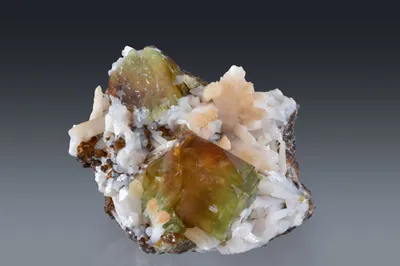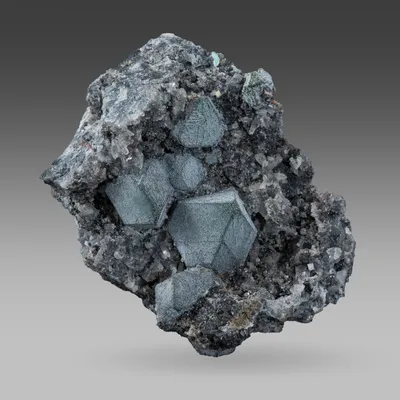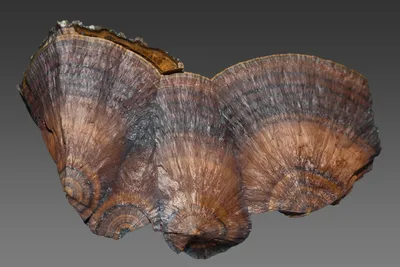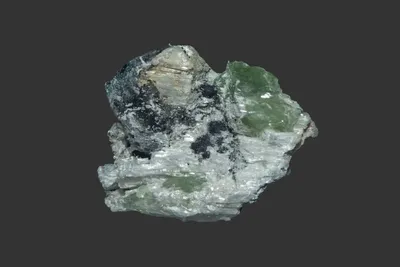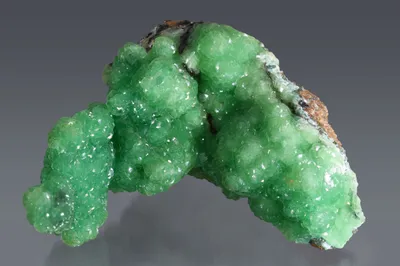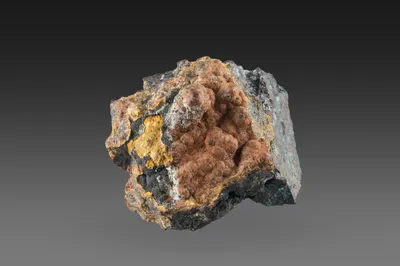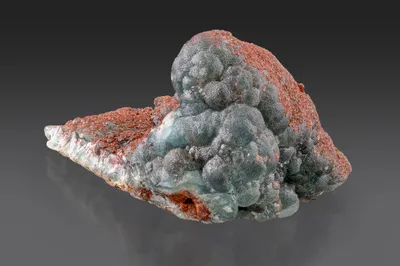Mineral Species
Hemimorphite
Type Locality
No
Composition
Zn4Si2O7(OH)2.H2O
Crystal System
Orthorhombic
Status at Tsumeb
Confirmed
Abundance
Very rare
Distribution
First and second oxidation zones
Paragenesis
Supergene
Entry Number
Species; TSNB164
General Notes
Hemimorphite occurs in both the first and second oxidation zones and appears to have been relatively common at outcrop and in the early open pit workings where it was associated with hydrozincite and aurichalcite. It was first recorded at Tsumeb by Maucher (1908a) as "calamine", an obsolete name that encompasses both hemimorphite and smithsonite and which appears on some older specimen labels.
The association of hemimorphite with aurichalcite and hydrozincite appears to have been restricted to the near-surface environment (i.e., the upper portion of the first oxidation zone). One of the earliest Tsumeb specimens in the collection of the Natural History Museum, London, obtained in 1909 (BM.1909,104), provides a fine example of this paragenesis.
Curiously, Strunz et al. (1958a) omit hemimorphite from their list of first oxidation zone minerals. They include it in their inventory of second oxidation zone species, however, and suggest that it is a mineral "… new for Tsumeb", apparently discounting early records of "calamine".
From 29 Level, in the second oxidation zone, hemimorphite was noted as a component of the type assemblage for reinerite, accompanied by adamite, hydrozincite, olivenite, smithsonite and willemite, on a chalcocite / bornite matrix (Geier and Weber, 1958).
Bartelke (1976) described yellowish masses of hemimorphite and rare colourless to white tabular crystals. Pinch and Wilson (1977) offered a similar description stating that hemimorphite "Forms colorless to white, pale blue or yellowish masses and small, tabular crystals to a few mm in size."
Keller (1984) pointed out that hemimorphite was more abundant in the first oxidation zone than in the second, and that it is generally an inconspicuous mineral at Tsumeb.
Lombaard et al. (1986) considered hemimorphite rare or very rare at Tsumeb.
Gebhard (1999) recorded that a single specimen was found by TCL mineralogist John Innes in 1985 comprising a 1 cm hemimorphite crystal penetrating a bundle of smithsonite crystals. In fact, the catalogue of the Innes Collection (prepared by Ernie Nickel, c. 1993, unpublished) lists three specimens that broadly match this description. One of Innes’ specimens is now in the Pinch Collection at Harvard University (MGMH 2020.7.2030); it carries Innes’ original handwritten label which indicates that it was collected from East 9 on 31 Level on 28 May 1979. Its relationship to the complex East 9 Pillar assemblage (Keller and Bartelke 1982, page 145 – Table 1) is unclear.
Von Bezing et al. (2016) noted the occurrence of hemimorphite with smithsonite and hematite.
Hemimorphite has also been found in association with mimetite and calcite, although the level of the mine from which this paragenesis was recovered is not known (Southwood Collection; MS 2013.142).
Associated Minerals
adamite; aurichalcite; azurite; bornite; calcite; chalcocite; chrysocolla; galena; goethite; hematite; hydrozincite; lanarkite (?); mimetite; olivenite; philipsburgite; quartz; reinerite; smithsonite; tsumcorite; willemite; zincrosasite (?)
